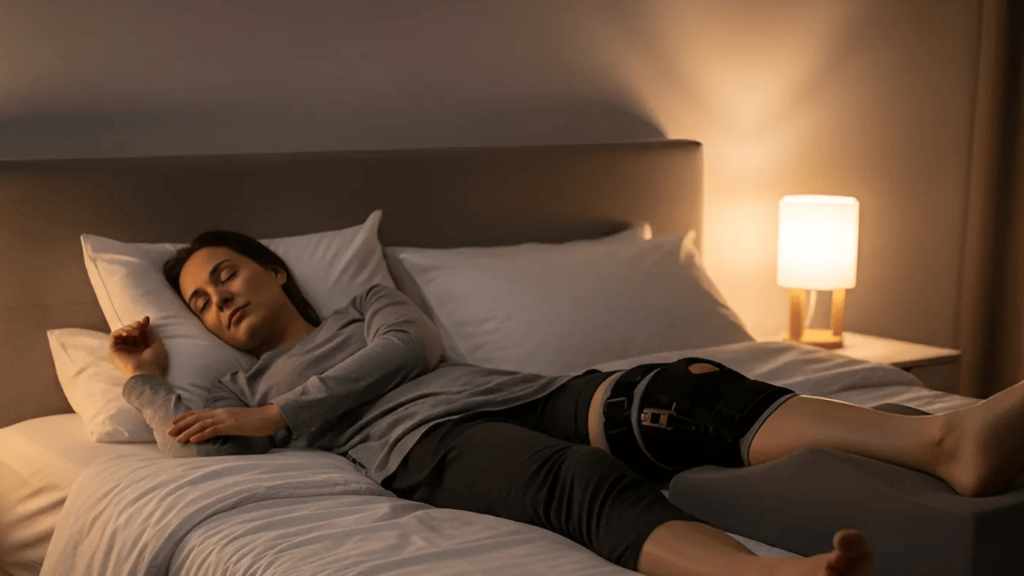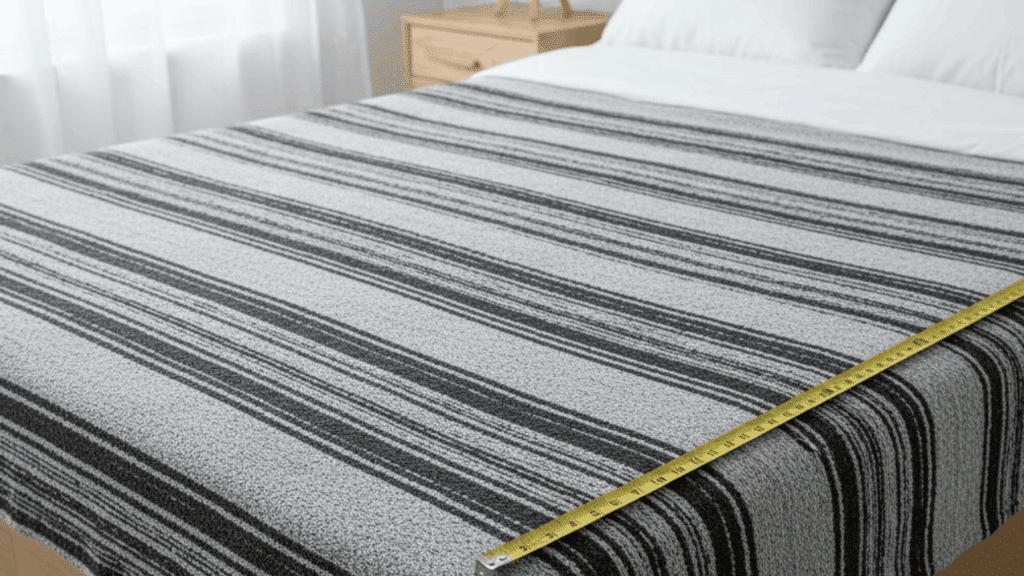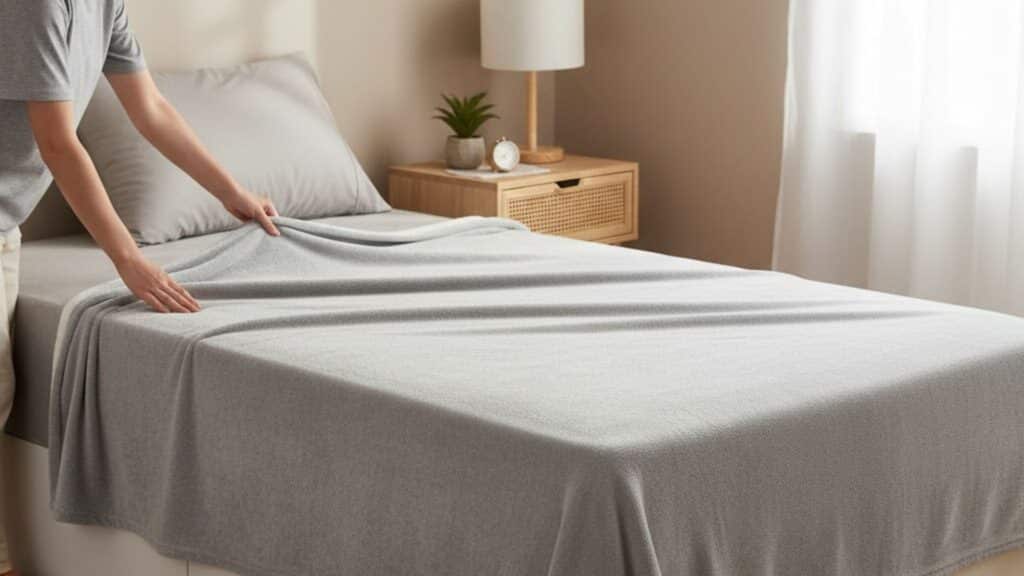Getting quality sleep after ACL surgery can feel nearly impossible. I remember how tough it was, your knee aches, you’re stuck in one position, and even the smallest movement seems to wake you up.
If you’re wondering how to sleep after ACL surgery without tossing and turning all night, you’re not the only one, and I’m here to help.
I’ll show you the best sleeping positions for each stage of recovery, how to manage nighttime pain, and a few tips to make your sleep space more comfortable. I’ll also share tools that can actually help.
Let’s figure out what really works and get your body the rest it needs.
Why Sleep is Difficult After ACL Surgery
Sleeping after ACL surgery can be frustrating. You’re dealing with pain, limited mobility, and mental stress, all of which can make it hard to get the rest your body needs to heal.
Pain, Swelling, and Restricted Movement
Your knee is sore and swollen after surgery, which makes even small movements uncomfortable. It may ache constantly or pulse when you try to relax.
Swelling can cause stiffness, and wearing a brace keeps your leg locked in one position. This limits how you can move in bed and makes it harder to find a position that feels right.
Mental Stress and Discomfort
Along with the physical pain, you may feel anxious or tense about sleeping in the wrong position.
The fear of accidentally bending your knee or rolling onto your surgical leg can keep your mind racing at night. On top of that, the awkward feeling of being stuck in one position can make you restless.
Why Sleep Matters for Recovery
Sleep is when your body does the most healing. It reduces inflammation, helps with pain control, and repairs tissues.
Without enough rest, your recovery may take longer and feel harder. That’s why finding ways to sleep more comfortably is an important part of your healing process.
How to Sleep After ACL Surgery: Positions by Recovery Phase
Your sleeping position affects how well and how fast you heal. As you move through recovery, the way you sleep should adjust, too. Here’s what to expect at each stage:
Weeks 1–2: Back Sleeping with Elevation

In the first couple of weeks, sleeping on your back is the safest option. Keep your surgical leg straight and raised slightly above your heart. This helps control swelling and keeps blood flowing properly.
Use a firm pillow or wedge under your calf and ankle for support. Keep your brace locked at night to prevent movement.
Weeks 3–5: Starting to Sleep on Your Side
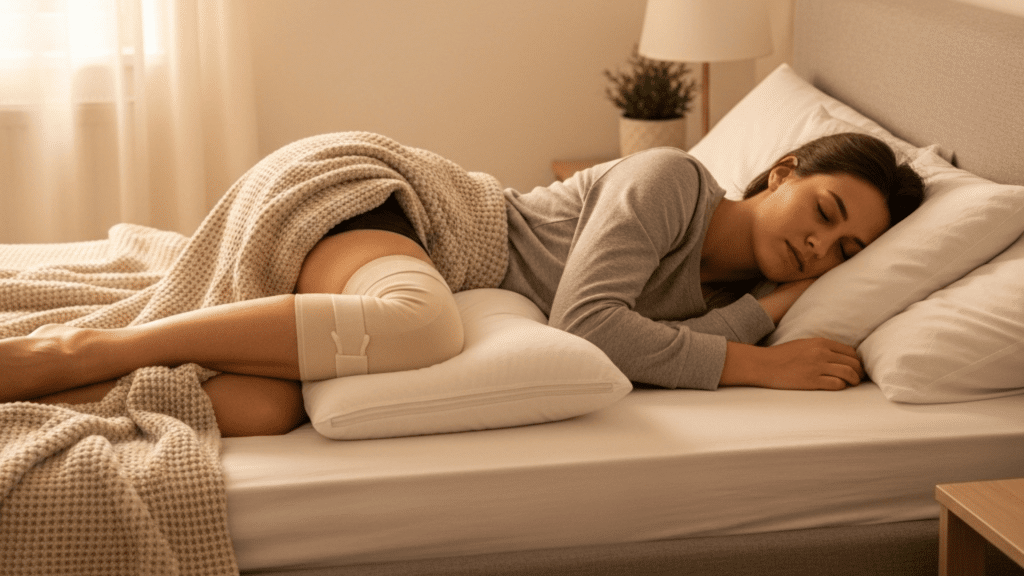
Once your doctor gives you the green light, you may be able to sleep on your side.
Place a pillow between your knees to keep your surgical leg aligned and supported. This reduces pressure on your knee and helps keep your body in a stable position overnight.
Week 6 and Beyond: Returning to Normal

By this stage, some people feel ready to sleep in their usual position. You might no longer need the brace, depending on your progress and your surgeon’s advice.
If you try sleeping without pillows or switch to your stomach, make sure your knee feels stable and pain-free. If anything feels off, go back to a safer setup.
Managing Pain and Discomfort at Night After ACL Surgery
Pain is one of the biggest reasons people struggle to sleep after ACL surgery. Managing it the right way can help you rest better and heal faster.
1. Take Pain Medication as Directed
If your doctor gave you pain medicine, take it before bed. This can help reduce swelling and dull the pain enough to help you relax.
Don’t skip doses at night unless your doctor tells you to. Staying ahead of the pain is better than trying to fix it once you’re already hurting.
2. Ice Your Knee Before Bed
Using an ice pack for 15 to 20 minutes before bedtime can help bring down swelling. It also numbs the area and makes it easier to fall asleep. Just be sure to wrap the ice pack in a cloth or towel so it doesn’t touch your skin directly.
3. Elevate Your Leg Properly
Keeping your leg raised above heart level helps reduce pressure and pain. Stack firm pillows under your calf and ankle, not your knee. Letting your knee hang unsupported can actually make it worse.
4. Keep the Brace On (If Recommended)
Your brace keeps your knee steady and safe while you sleep. If your doctor says to wear it at night, make sure it’s locked and fitted properly. A moving joint can cause pain and slow healing.
5. Focus on Comfort
Use extra pillows for support behind your back, under your arms, or wherever you feel tension. A soft blanket, a quiet room, and a cool temperature can also help your body relax.
Should You Sleep With a Brace On After ACL Surgery?
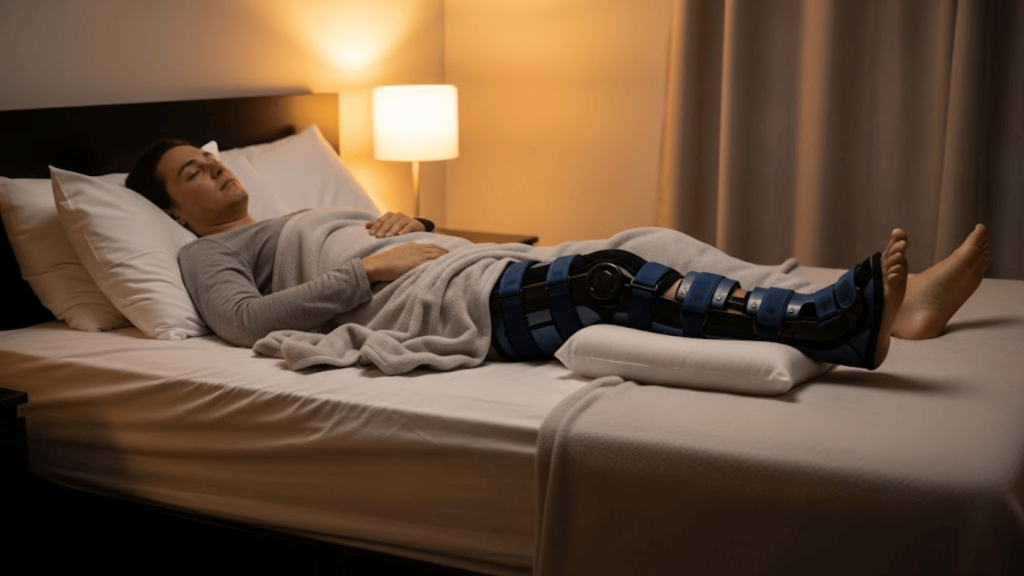
Wearing a knee brace while you sleep might feel uncomfortable, but in the early stages of recovery, it plays a key role in protecting your knee.
Why the Brace Matters
Right after surgery, your knee is weak and unstable. A locked brace keeps it straight and prevents accidental bending or twisting. Even small movements during sleep can put strain on the healing ligament. The brace helps lower that risk while you rest.
When to Wear It at Night
Most doctors recommend wearing the brace while sleeping for at least the first 2 to 3 weeks. Some patients may need to keep it on longer, depending on how their recovery is going.
Always follow your surgeon’s advice. If your doctor says to wear it, don’t skip it even if it feels bulky or annoying.
When It’s Safe to Stop
As your knee gets stronger and you gain more control, your doctor might tell you it’s okay to stop using the brace at night. This usually happens after the swelling goes down and you can move without pain.
Never stop wearing it at night unless your doctor gives you clear instructions to do so.
Extra Tips for Better Sleep After ACL Surgery
Small adjustments to your bedtime routine and sleep setup can make a big difference in how well you rest during recovery. These tips focus on comfort, consistency, and pain relief.
- Cool and quiet environment: Keep your room dark, quiet, and slightly cool to help your body relax naturally before sleep.
- Consistent bedtime routine: Go to bed and wake up at the same time each day. This helps your body settle into a rhythm.
- Limit caffeine and heavy food: Avoid coffee, tea, or large meals close to bedtime. These can keep you awake or make you uncomfortable.
- Supportive pillow setup: Use extra pillows to support your body under your head, behind your back, or under your arms.
- Calming wind-down activities: Try reading, light stretching, or deep breathing instead of screens right before bed.
These simple changes can ease discomfort, reduce restlessness, and help you fall asleep faster during your recovery process.
Must-Have Sleep Aids During ACL Recovery
Some simple products can make your sleep more comfortable and your recovery smoother. These aids support your leg, reduce pain, and help you stay in the right position all night.
- Wedge pillow for elevation: Keeps your leg raised above heart level to reduce swelling and improve circulation while you sleep.
- Knee pillow for side sleeping: Helps keep your legs aligned and takes pressure off your healing knee when lying on your side.
- Recliner or adjustable bed: Offers better leg support and can be more comfortable than lying flat during early recovery.
- Soft blanket and firm mattress: A soft blanket adds comfort, while a firm mattress gives your body the support it needs.
- Ice packs with wrap straps: Useful before bed to numb pain and reduce swelling without making a mess.
These tools aren’t required for everyone, but they can make a big difference in how well you rest and recover during the first few weeks.
Wrapping Up
Learning how to sleep after ACL surgery can make a real difference in how smoothly and how quickly you recover.
I know it’s not always easy to get comfortable in those first few weeks, but with the right position, a few comfort tools, and a steady routine, you can start sleeping better.
Use what you’ve picked up here to take pressure off your knee and rest with more confidence. Sleep may not fix everything, but it’s one part of recovery you can actually control.
Want more simple, step-by-step tips to help your body heal? Read other blogs on the website for down-to-earth recovery advice that works in real life.


